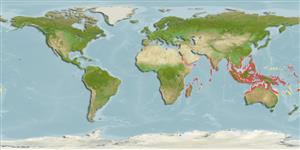>
Ovalentaria/misc (Various families in series Ovalentaria) >
Pomacentridae (Damselfishes) > Pomacentrinae
Etymology: Amphiprion: Greek, amphi = on both sides + Greek, prion, -onos = saw (Ref. 45335).
More on author: Bleeker.
Environment: milieu / climate zone / depth range / distribution range
Ekologi
marina revassocierade; ej vandrande; djupintervall 3 - 25 m (Ref. 9710). Tropical; 23°N - 35°S
Indo-West Pacific: East Africa, Madagascar, Comoro Islands, Seychelles, Andaman Sea, Sumatra and the Seribu Islands (Java Sea). Not found in Maldives and Sri Lanka (Ref. 4391).
Size / Vikt / Age
Maturity: Lm ? range ? - ? cm
Max length : 11.0 cm SL hane/ej könsbestämd; (Ref. 5911)
Short description
Bestämningsnycklar | Morfologi | Morfometri
Taggstrålar i ryggfenan (totalt) : 8 - 9; Mjukstrålar i ryggfenan (totalt) : 17 - 20; Taggstrålar i analfenan: 2; Mjukstrålar i analfenan: 12 - 14.
Found in shallow inshore reef habitats, often in strong current zones to about 15 m depth (Ref. 48636). Are protandrous hermaphrodites (Ref. 55367). Each pair is monogamous (Ref. 55367). Each anemone with a large female, a smaller functional male and several stunted juveniles; with the removal of the female, the male changes sex and the largest of the juveniles develops into a functional male (Ref. 4391). Oviparous, distinct pairing during breeding (Ref. 205). Eggs are demersal and adhere to the substrate (Ref. 205). Males guard and aerate the eggs (Ref. 205). Associated with the anemones: Heteractis magnifica, and Stichodactyla mertensii (Ref. 5911). May be reared in captivity (Ref. 35420).
Life cycle and mating behavior
Könsmognad | Reproduktion | Lek | Ägg | Fecundity | Larver
Benthic spawner. Sex reversal is completed in less than 63 days (Ref. 34185). Length at sex change = 7.2 cm TL (Ref. 55367). Oviparous, distinct pairing during breeding (Ref. 205). Eggs are demersal and adhere to the substrate (Ref. 205). Males guard and aerate the eggs (Ref. 205). Also Ref. 7471.
Allen, G.R., 1986. Pomacentridae. p. 670-682. In M.M. Smith and P.C. Heemstra (eds.) Smiths' sea fishes. Springer-Verlag, Berlin. (Ref. 4391)
IUCN Red List Status (Ref. 130435: Version 2024-1)
Threat to humans
Harmless
Human uses
Fiskeri: saknar intresse; Akvarium: Kommersiell
Verktyg
Special reports
Download XML
Internet-källor
Estimates based on models
Preferred temperature (Ref.
123201): 25.6 - 29.3, mean 28.6 °C (based on 2542 cells).
Phylogenetic diversity index (Ref.
82804): PD
50 = 0.5000 [Uniqueness, from 0.5 = low to 2.0 = high].
Bayesian length-weight: a=0.01479 (0.00651 - 0.03363), b=3.00 (2.81 - 3.19), in cm total length, based on LWR estimates for this (Sub)family-body shape (Ref.
93245).
Trofisk nivå (Ref.
69278): 2.7 ±0.31 se; based on food items.
Resiliens (Ref.
120179): Hög, lägsta populationsfördubblingstid mindre än 15 månader (Preliminary K or Fecundity.).
Fishing Vulnerability (Ref.
59153): Low vulnerability (10 of 100).
Nutrients (Ref.
124155): Calcium = 111 [62, 177] mg/100g; Iron = 0.785 [0.498, 1.219] mg/100g; Protein = 18.6 [17.5, 19.6] %; Omega3 = 0.146 [0.094, 0.224] g/100g; Selenium = 21.5 [12.8, 38.2] μg/100g; VitaminA = 143 [49, 416] μg/100g; Zinc = 2.07 [1.45, 2.84] mg/100g (wet weight);
